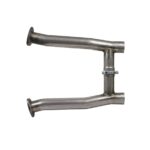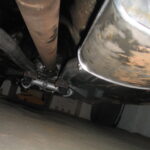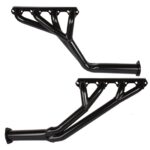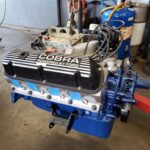Return to the prior page My GT 350
The 302 engine needs to breathe better. The stock exhaust headers were restrictive. If the engine has to work to push the exhaust out horse power is robbed. The Ford small block really needs a good exhaust to maximize the synergy of the engine.
Back in the 60’s when Shelby American was racing 289 engines the team came up with the Tri-Y headers. How the header is designed affects the results. The Shelby team wanted the small block headers to maximize the torque curve. The Tri-Y headers give good low and mid-range rpm torque with a nice torque curve.
The long tube Tri-Y headers were invented specifically for the Shelby Mustang GT-350. They are called Tri-Y because of how they look. Four tube, full length headers. (Shorty headers are not full, long tube. The exhaust pipe comes up to the shorty header.) The Tri-Y’s tubes are long enough for the collectors to go under the car to the exhaust pipes.
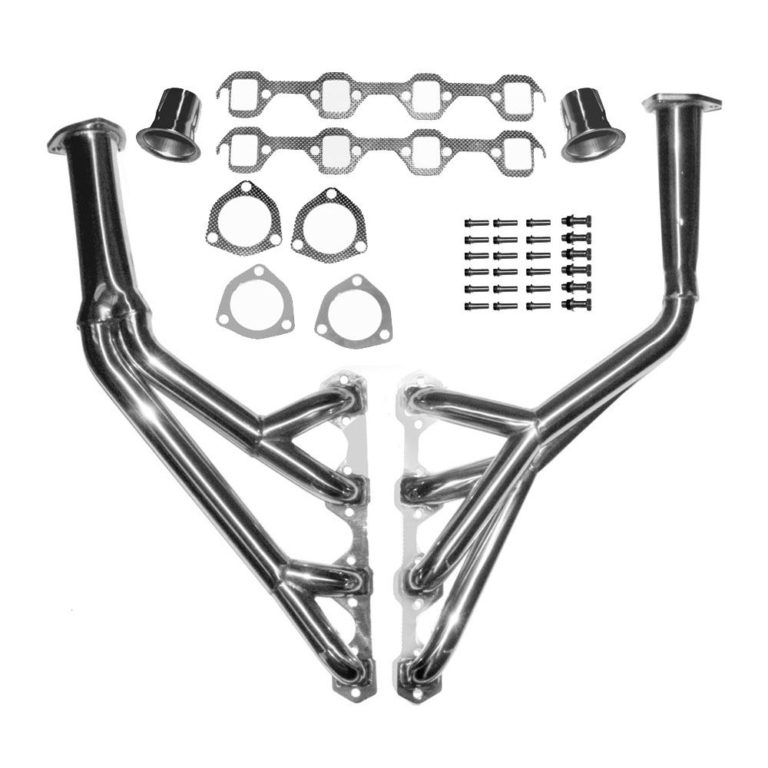
The Tri-Y design is a short primary tube that is paired with another cylinder that is synchronized in the firing order into a 2-into-1 collector that then goes to a larger diameter secondary tube. The two secondary tubes merge into a final 2-into-1 collector creating an overall length similar to a 4-into-1 header design, Three Y’s. This design works well to add torque from idle to 5,000 rpm. Perfect for the street. NASCAR used a variation of the design with longer primary and secondary tubes for higher rpm.
A set of headers needs to be tuned to the application. The diameter and length alter the power band of the engine. Rule of thumb is you want a header that is small enough that it will not hinder the high rpm flow of exhaust. Smaller diameter tubes keep the exhaust velocities high and that is where the engine produces the most torque. Bigger is not always better especially if you want good low to mid-range torque, street torque.#
The function of the headers is to allow the exhaust stroke of the engine to push the gases out with minimal back pressure. If the exhaust is not emptied, the remaining gases will stay in the cylinder and dilute the air & fuel entering the cylinder hurting power. And power is also wasted trying to push the gases out.
I pasted the specs from Scott Drake, the vendor I got my set of Tri-Y headers from at the bottom of this page.
——————–
# Source of info from Mustang 360 -Header Performance Guide For Mustangs by Jim Smart
” Source Hotrod.com How to Pick the Right Header 11-12-2013 by Christopher Campbell https://www.hotrod.com/articles/how-to-pick-the-right-header/
———————-
H Pipe
Once the headers take the exhaust away from the engine, the exhaust goes down the exhaust pipes out the tail pipe. Before the exhaust reaches the tailpipe, I added an H pipe just behind the header collectors. An H pipe equalizes the pressure between the two sides of the engine. It helps maintain the back pressure for a gain in torque early in the rpm band.
I had a custom exhaust made for my car in 2010. What was there was rusted out when I started it in the spring. It was just as cheap to have a local shop make me a custom setup as it was to order already made setup. I actually did that first and discovered there was no way that exhaust setup sent to me was going to fit my car. Shipped it back and had a custom exhaust made. The shop included an H pipe.
Specs on my Tri-Y Headers
Brand: Scott Drake
Manufacturer’s Part Number: C5ZZ-9430-SS
Part Type: Headers
Product Line: Scott Drake Headers
Summit Racing Part Number: SDK-C5ZZ-9430-SS
UPC: 00842110115270
Header Style: Tri-Y
Header Material: Stainless steel
Header Finish: Natural
Weld-Up: No
Primary Tube Outside Diameter (in): 1 1/2 – 1 3/4 in.
Flange Style: Standard
Collector Attachment: 3-bolt flange
Collector Diameter: 2.500 in.
Collector Reducers Included: Yes
Collector Reducer Exit Diameter: 2.250 in.
Tuned: No
Flange Thickness (in): 5/16 in.
Bolts/Studs Included: Yes
Gaskets Included: Yes
Crossover Pipe Included: No
Catalytic Converter(s) Included: No
Motor Mounts Included: No
Transmission Mount Included: No
Quantity: Sold as a pair.
